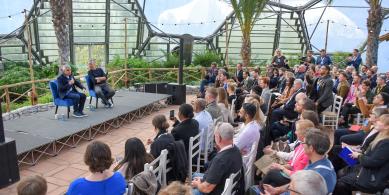In the Oscar-nominated movie ‘The Martian’ Matt Damon plays a NASA botanist stuck on Mars. His crew have departed as they have (reasonably) assumed he has been killed by an accident during their mission.
Damon survives, and wakes up to the magnitude of his situation. It will be several years before a rescue mission can reach him - but he only has sufficient supplies to last a few months.
But as a highly-qualified scientist, he does not panic. Nor does he give up and accept his fate. He decides to solve the problem in the most effective way possible.
In his own words - he decides to “science the sh*t” out of the problem.
He consults the notes left behind by his colleagues, and experiments using the limited resources at his disposal (including a highly creative way of growing potatoes). And keeps himself alive.
Not only is it a great movie, but it’s a metaphor for the way science has solved problems in the world we live. The houses we live in, the food we eat, the transport we use. All of these things were developed by scientists using the scientific method.
A hypothesis, followed by a deduction, and tested through observation. Then repeat.
And yet… why is so little work in the communications industry scientifically based, with little to no experimentation?
Isn’t it time we took this guesswork out of communications, and started sciencing the sh*t out of it? And, like Matt Damon with his potatoes, use that grounding in science to creatively grow something that will keep your business well fed?
It is particularly baffling as there is a wealth of scientific evidence out there. We now have a much better idea what works, and how communications can successfully influence behaviour.
The academic disciplines of behavioural economics, social psychology and neuroscience (collectively behavioural science) have given us a richer understanding of what drives human behaviour in recent years – specifically the importance of subconscious influences on decision-making.
More and more governments and businesses are now recognising that a behaviour-first, scientifically-led approach can use the insights of behavioural and marketing science to solve a range of communication challenges. In my own work I have successfully optimised call centre and live chat scripts, website and app user experience, advertising and direct marketing copy and layout, as well as internal communications, using this approach.
This experience has shown that everything communicates, and how you say it matters as much as what you say. Context is everything – which is why experimentation is so important.
For example, using social norms as a messaging approach (e.g. “other people like you have done this”) works best when talking to people about behaviours important to their identity and ego (e.g. wanting to be seen as a good person), such as fostering collaboration or sustainability. When speaking to a small business leader, who primarily seeks competitive advantage (i.e. doing what everyone else isn’t), that won’t motivate a change in behaviour.
Furthermore, the tools of digital communications and new advances in machine learning mean the opportunities to test and learn at speed and scale (and for low cost) are endless. From simple A/B split copy tests, to programmatic algorithms employed for sophisticated psychometric targeting of messaging, to pre-testing content based on cognitive psychological research, the platforms now exist to test and optimise messaging based on specific motivations - rather than generic assumptions based on arbitrary demographic traits like age, gender, or location.
But you don’t have to take my word for it (that wouldn’t be very scientific, would it?). The beauty of a science-led approach is that by testing hypotheses like these you can find out for sure what works in what context.
That’s how science built the world we live in today – I believe communication shouldn’t be any different.
Some quick tips
- Context is critical, so testing in a way that reflects the actual environment as closely as possible (e.g. via a controlled pilot) is critical.
- Recognise that the behaviours you want to influence may be driven by subconscious motivations, which will not be obvious from simply speaking to your audience.
- Build multiple hypotheses for testing. Finding ‘silver bullets’ is rare, so it is likely that different approaches may be needed for different audiences.
Richard Chataway is Vice-President of BVA Nudge Unit UK, founder of Communication Science Group and a speaker/trainer on behavioural science and communications. He is also a board member of the Association for Business Psychology, and his book ‘The Business of Behaviour’ will be published later this year.
Newsletter
Enjoy this? Get more.
Our monthly newsletter, The Edit, curates the very best of our latest content including articles, podcasts, video.
Become a member
Not a member yet?
Now it's time for you and your team to get involved. Get access to world-class events, exclusive publications, professional development, partner discounts and the chance to grow your network.




